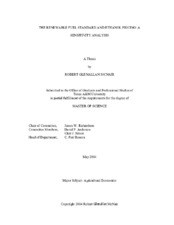| dc.description.abstract | Volatile oil prices and political uncertainty surrounding uninterrupted oil supplies has pressured the U.S. Congress and economists to search for substitutes. In response, the U.S. has enacted policies to directly support the production and use of biofuel. The current Renewable Fuel Standard (RFS) requires 36 billion gallons of renewable fuel use by 2022. A large proportion of the mandate is to consist of corn-based ethanol. Most ethanol is consumed in the U.S. as a 10 percent blend of ethanol and gasoline. In 2014, it is projected oil refineries will hit the blend wall (BW). In short, oil refineries are required to blend more ethanol into gasoline than is allowed by the Environmental Protection Agency (EPA). As a consequence, the EPA will need to either reduce the Renewable Fuel Standard for 2014, or permit additional ethanol blends to be sold.
Overall, the purpose of the study was to analyze the economic impact of changing energy policy on ethanol markets. A structural, supply and demand model was developed. Four equations were estimated, and residuals were simulated to estimate probability distributions for monthly ethanol prices and total demand. Alternative scenarios were developed to estimate how the RFS, the BW, and corn prices affect ethanol markets.
The parameter estimates indicated the major determinants of ethanol demand were the RFS and the BW. The results showed the RFS and the BW positively affected the price of ethanol and demand. The base scenario estimated average ethanol price to be $1.89/gal. When the RFS was reduced by 10.59 percent, ethanol prices were estimated to decline $0.29/gal, compared to the base scenario. Total demand declined 600 million gallons. If the BW was increased to 15 percent, the price of ethanol increased approximately $1.10/gal from the base scenario. Total demand increased 1.4 billion gallons in response. Ethanol prices were found to be insensitive to corn prices. | en |


